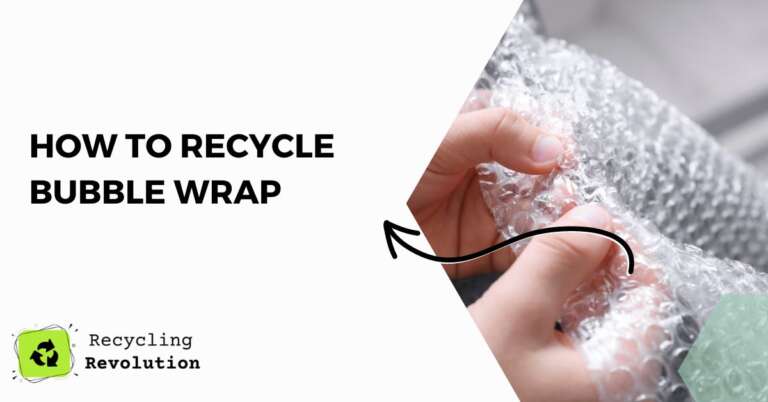Firstly, let’s clarify what bubble wrap is. It’s a pliable, transparent plastic material regularly used for packaging fragile items.
Comprised of numerous small air-filled bubbles, it provides a cushioning effect, preventing damage during transit. It’s also a type of plastic film, which puts it in a unique category when it comes to recycling.
TL;DR: Recycling bubble wrap isn’t as simple as tossing it in your curbside recycling bin. To recycle bubble wrap properly, you’ll need to take it to a drop-off location that accepts plastic film products, such as grocery stores.
Alternatively, consider reusing it for various purposes around the house or office, or donate it to local businesses or charities.
Why Can’t I Put Bubble Wrap in My Curbside Bin?
Here’s the catch: while bubble wrap is made of recyclable plastic (typically #4 LDPE), it can’t go in most curbside recycling bins. The problem lies not in the material itself, but rather in the form it takes.
Bubble wrap and other soft plastics can jam the sorting machines used at recycling facilities. This can cause significant delays and increased costs for recycling operations.
Note: Just because you can’t put it in your curbside recycling bin doesn’t mean bubble wrap can’t be recycled. You’ll just need to take it to a specialized location.
How to Recycle Bubble Wrap: The Steps
- Collect Your Bubble Wrap: Start by gathering all your bubble wrap. It can be from packages you’ve received, or perhaps from a recent move.
- Prepare for Recycling: Next, prepare your bubble wrap for recycling. Remove any tape or labels from the bubble wrap. Dirty or heavily marked bubble wrap may not be accepted, so try to keep it as clean as possible.
- Find a Drop-Off Location: Look for local retailers, grocery stores, or recycling centers that accept plastic film products. These places often have designated bins for these materials. Websites like plasticfilmrecycling.org can help you locate drop-off locations in your area.
- Drop it Off: Bring your collected bubble wrap to the chosen drop-off location and deposit it in the designated bin.
- Buy Less Bubble Wrap: While recycling is good, reducing your use of bubble wrap in the first place is even better. Consider alternatives like newspaper or shredded paper for packaging needs.
The Environmental Impact of Bubble Wrap
Like many plastic items, bubble wrap can take hundreds, if not thousands, of years to degrade.
The improper disposal of bubble wrap contributes to environmental pollution, affecting ecosystems and wildlife adversely. By recycling or reusing bubble wrap, you are actively helping to mitigate these issues.
Not All Bubble Wrap is Recyclable
While bubble wrap is generally recyclable, it’s important to mention that not all bubble wrap is made the same. Most bubble wrap can be recycled with plastic bags, but if the material has a metallic film, it is not recyclable.
The same applies to bubble wrap that has been colored or dyed. Before dropping off your bubble wrap for recycling, it’s essential to check if it meets the recycling requirements.
Innovative Ways to Reuse Bubble Wrap
Aside from its conventional uses for packaging and insulation, bubble wrap can be put to other creative uses. Let’s explore a few.
As a Greenhouse Material
Bubble wrap can be used to insulate a small greenhouse or a cold frame. Its insulating properties help to trap heat, while its transparency allows sunlight to reach the plants.
DIY Craft Projects
Bubble wrap is a fun material to incorporate into DIY craft projects. For instance, you can make decorative prints by applying paint to a piece of bubble wrap and pressing it onto a piece of paper or fabric.
Stress Relief
Another interesting use of bubble wrap is as a stress relief tool. The process of popping the bubbles in the wrap can be therapeutic and a great way to relieve stress.
You can keep a small piece of it on your desk for whenever you need a stress relief break.
Community Initiatives and Programs for Bubble Wrap Recycling
Another aspect worth exploring is the existence of community recycling programs and initiatives. Some cities, communities, or companies run specialized programs that deal with materials like bubble wrap.
If you run a business that generates a significant amount of bubble wrap or similar material, it’s worth investigating whether such programs exist in your area.
Note: Always ensure to inquire about the specific requirements of such programs, as they might have rules about the conditions of the bubble wrap they accept.
Investing in Eco-Friendly Alternatives
As we strive for a sustainable future, investing in eco-friendly alternatives to bubble wrap is crucial. Biodegradable bubble wrap, for instance, decomposes naturally over time and leaves no harmful residues.
Other eco-friendly packing materials include corrugated bubble wrap, air pillows made from recycled materials, and organic materials like straw or hay.
The Importance of Reducing Bubble Wrap Consumption
While recycling and reusing bubble wrap are great steps toward eco-friendly practices, the ultimate goal should be reducing our consumption of such materials. Reduction is the first of the three R’s (Reduce, Reuse, Recycle), and for a good reason.
By minimizing our demand for new bubble wrap, we can significantly reduce the environmental impact associated with its production and disposal.
To reduce your use of bubble wrap, consider whether you need it in the first place or if alternatives would work just as well. For example, if you’re packing a small, non-fragile item, perhaps some shredded paper or a small cloth would suffice.
Alternatives to Recycling Bubble Wrap
Even though recycling is an option, I highly recommend reusing bubble wrap whenever possible.
For Packaging
Bubble wrap is excellent for protecting fragile items in storage or during a move. Keep a stash in your home for any packaging needs that may arise.
For Insulation
Bubble wrap can be used to insulate windows in the winter months, helping to keep your home warm without cranking up the heat.
Donate It
Local businesses, charities, schools, or community centers might be in need of packaging materials. Call around and see if they could use your bubble wrap.
Conclusion
Recycling bubble wrap may seem complicated, but with a little effort, it’s entirely achievable. Instead of sending it straight to the landfill, either recycle it at a suitable drop-off location or consider reusing it around your home or office.
Not only will you help conserve resources, but you’ll also contribute to a cleaner and healthier environment.
FAQ
Can I put bubble wrap in my recycling bin?
No, most curbside recycling programs do not accept bubble wrap. It needs to be taken to a specific drop-off location that accepts plastic film products.
Can bubble wrap be reused?
Absolutely! I recommend reusing bubble wrap for packing, insulation, or craft projects before considering recycling.
What are alternatives to bubble wrap for packing?
You can use newspaper, old clothes, towels, shredded paper, or biodegradable packing peanuts as alternatives to bubble wrap. Remember, the key to effective recycling is understanding what can be recycled, how, and where. Happy recycling!

